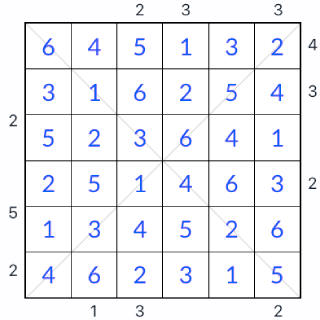Diagonal Consecutive Sudoku Hard
Like this puzzle!
7
9
4
9
3
7
8
4
6
3
8
8
6
4
3
9
7
3
1
2
4
8
9
7
6
1
2
3
4
5
6
7
8
9
?
~
123
1
2
3
Helping solve
Undo
Redo
Delete
0
Hint
Latest score list for #eqzr2
an
anonymous a second ago
13'37''
ma
makeup 14 minutes ago
13'46''
an
anonymous 25 minutes ago
13'47''
pr
programs 31 minutes ago
7'13''
Cl
Classes an hour ago
3'27''
So
Sophia an hour ago
18'43''
an
anonymous 55 minutes ago
18'43''
wo
workforce 48 minutes ago
15'23''
gu
guest 38 minutes ago
10'22''
gu
guest 44 minutes ago
3'40''
Latest score list for Diagonal Consecutive Sudoku
pr
programs solved puzzle No#6d4mj;
17'40''
fi
finance solved puzzle No#w81m2;
17'7''
gu
guest solved puzzle No#1ypw9;
17'50''
an
anonymous solved puzzle No#1y1vr;
13'38''
te
technology solved puzzle No#1y1vr;
7'45''
pr
premium solved puzzle No#dm0k0;
17'34''
Fi
Fitness solved puzzle No#jnq69;
7'17''
gu
guest solved puzzle No#gwqp2;
11'26''
an
anonymous solved puzzle No#45mm5;
14'14''
gu
guest solved puzzle No#y1xzp;
5'23''
How to play Diagonal Consecutive Sudoku
Diagonal Consecutive Sudoku Rules
Consecutive Sudoku: Standard Sudoku rules apply (1-9 in each row, column, and box) with the added twist of bars between some squares. These bars mean the numbers in those squares must be consecutive (differ by 1).
Diagonal Consecutive Sudoku Additional Rules:
-
Diagonal Sudoku Rule: Sudoku main diagonals also contain the digits 1 through 9.
Read more: Diagonal Consecutive Sudoku rule & tips
Using the Markings:
Pay close attention to the consecutive markers while placing numbers. If two cells are connected by a bar, the numbers you place in them must differ by exactly 1.
Conversely, if there's no marking between two cells, the numbers in those cells cannot be consecutive.
Diagonal Consecutive Sudoku = Diagonal Sudoku + Consecutive Sudoku.
Privacy Policy Copyright Gridpuzzle © 2024


























